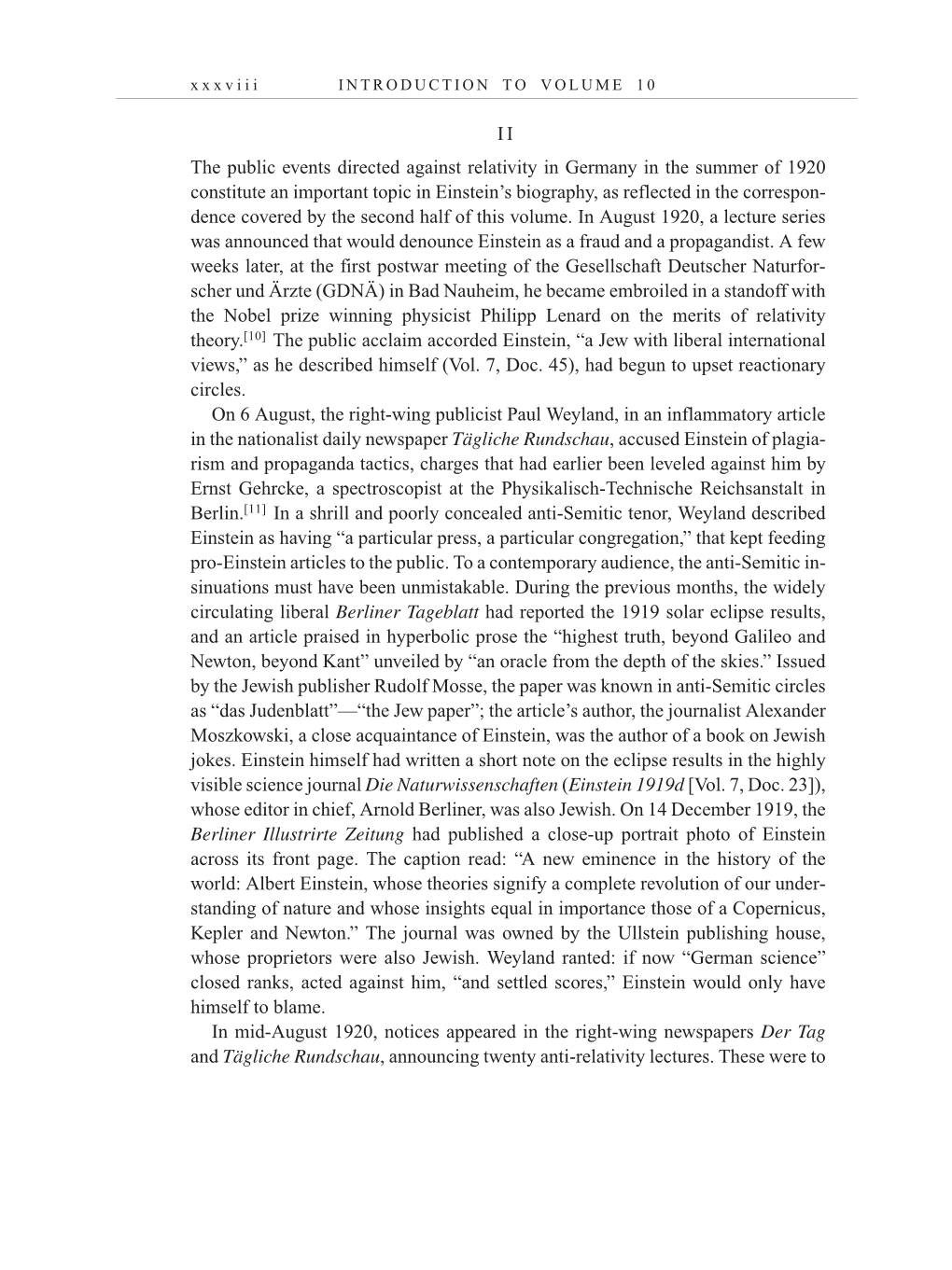x x x v i i i I N T R O D U C T I O N T O V O L U M E 1 0
I I
The public events directed against relativity in Germany in the summer of 1920
constitute an important topic in Einstein’s biography, as reflected in the correspon-
dence covered by the second half of this volume. In August 1920, a lecture series
was announced that would denounce Einstein as a fraud and a propagandist. A few
weeks later, at the first postwar meeting of the Gesellschaft Deutscher Naturfor-
scher und Ärzte (GDNÄ) in Bad Nauheim, he became embroiled in a standoff with
the Nobel prize winning physicist Philipp Lenard on the merits of relativity
theory.[10]
The public acclaim accorded Einstein, “a Jew with liberal international
views,” as he described himself (Vol. 7, Doc. 45), had begun to upset reactionary
circles.
On 6 August, the right-wing publicist Paul Weyland, in an inflammatory article
in the nationalist daily newspaper Tägliche Rundschau, accused Einstein of plagia-
rism and propaganda tactics, charges that had earlier been leveled against him by
Ernst Gehrcke, a spectroscopist at the Physikalisch-Technische Reichsanstalt in
Berlin.[11]
In a shrill and poorly concealed anti-Semitic tenor, Weyland described
Einstein as having “a particular press, a particular congregation,” that kept feeding
pro-Einstein articles to the public. To a contemporary audience, the anti-Semitic in-
sinuations must have been unmistakable. During the previous months, the widely
circulating liberal Berliner Tageblatt had reported the 1919 solar eclipse results,
and an article praised in hyperbolic prose the “highest truth, beyond Galileo and
Newton, beyond Kant” unveiled by “an oracle from the depth of the skies.” Issued
by the Jewish publisher Rudolf Mosse, the paper was known in anti-Semitic circles
as “das Judenblatt”—“the Jew paper”; the article’s author, the journalist Alexander
Moszkowski, a close acquaintance of Einstein, was the author of a book on Jewish
jokes. Einstein himself had written a short note on the eclipse results in the highly
visible science journal Die Naturwissenschaften (Einstein 1919d [Vol. 7, Doc. 23]),
whose editor in chief, Arnold Berliner, was also Jewish. On 14 December 1919, the
Berliner Illustrirte Zeitung had published a close-up portrait photo of Einstein
across its front page. The caption read: “A new eminence in the history of the
world: Albert Einstein, whose theories signify a complete revolution of our under-
standing of nature and whose insights equal in importance those of a Copernicus,
Kepler and Newton.” The journal was owned by the Ullstein publishing house,
whose proprietors were also Jewish. Weyland ranted: if now “German science”
closed ranks, acted against him, “and settled scores,” Einstein would only have
himself to blame.
In mid-August 1920, notices appeared in the right-wing newspapers Der Tag
and Tägliche Rundschau, announcing twenty anti-relativity lectures. These were to
